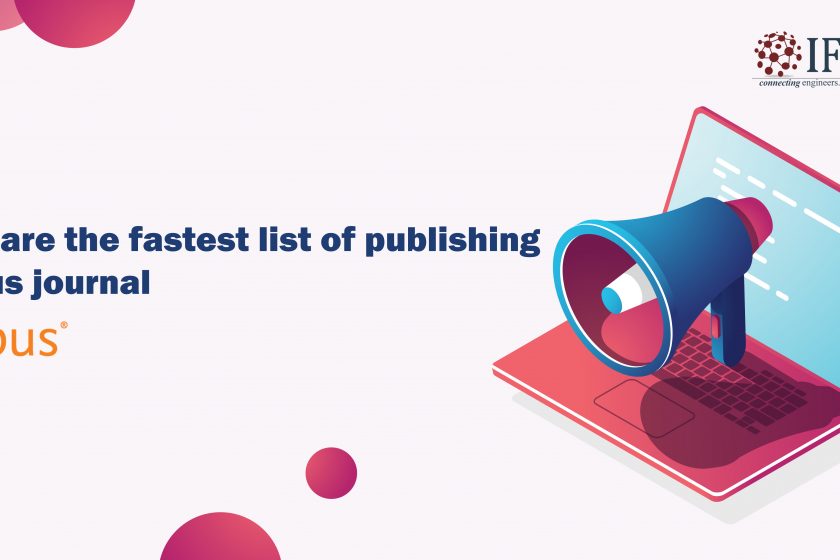When it comes to scientific journals, publication time is more than just a performance measure to keep track of. The slightest fluctuation in the number of days it takes for new research articles and papers to be published will directly affect how quickly new research findings can reach the people who need them and begin to have impacts both inside and outside academia. Now, in particular, as researchers rush to respond to the COVID-19 pandemic, the academic community is being reminded of the importance of the rapid dissemination of research.
Of course, peer review and publication (whether it be for renowned Scopus journals and publications or ordinary, non-indexed journals) should not be rushed unduly. However, through ingenuity and attention to detail, many aspects of journal operations can be optimized to reduce publication time. A lot of tips on how to streamline workflows to reduce release time, including the benefits of following a continuous release model and tips for reducing the transfer steps between review by reviewers, peers, and publication, have been shared in the past. But in the present situation, a lot of these are worthless and inapplicable. In this article, you will learn about a number of previously unknown ways to reduce the number of days it takes for the acceptance, reviewing, and publication of a manuscript.

- Tip #1
Follow All Peer Review Policies & Guidelines Put Forth By The Journal (You Have Chosen) To The Tee
- At the heart of an effective peer review process are clear editorial policies and procedures.
- It is important for journals not only to include high-level information on peer review policies on their websites but also to maintain more detailed documentation of policies and procedures that editors can consult when needed.
- Although documenting all the editorial processes may seem like a lot of upfront work, especially if the team seems already well aligned, there are many benefits to saving time.
- Documenting the editorial processes will help journals highlight existing or potential bottlenecks in their workflow that require immediate addressing.
- This will also help the editorial teams of journals to have a point of reference when updating journal policies and procedures to meet new requirements.
- Depending on the academic disciplines that a journal (be it a globally recognized Scopus indexed journal or otherwise) serves, its editorial processes and documentation may need to evolve more quickly to keep up with changing research standards and the needs of funders.
- In unique situations like the COVID-pandemic, editorial teams may find themselves having to keep abreast of research developments, taxonomies, or the development of access conditions for donors.
- Not only is it critical to communicate these types of updates verbally, but also to document them, with links to additional guides if needed, so that editors can find the latest information quickly.
- If you’re a researcher who is looking to have your research published, then aside from going through this article and following the tips specified within, you will also benefit greatly from taking an active part in conferences in your field.
- Check out this list of upcoming educational conferences to find an event that you’re interested in, and register immediately to save yourself a seat.
- Tip #2
Picking The Most Appropriate Journal Possible
- When it comes to picking the best journal, there is no magic formula, but these steps might help researchers decide –
- Looking For A Good Subject Match.
- The type, scale, and importance of a researcher’s work should match the type of material usually published in a journal.
- In other words, researchers should read some of the recently published content in the journal they intend to submit to.
- They should check their calls for research papers and see if they link them up, and also read their guidelines closely (as mentioned already).
- Take Advice From Experienced Writers
- Researchers that know someone who has experience with publishing in a particular journal should ask them for advice.
- Knowing which journal they are submitting to is important to help them target the right one.
- Using Metric Scores With Caution.
- There are roughly twelve quality signs of a great journal, and the impact factor isn’t the most important of them.
- Journals that have a high impact factor aren’t necessarily known for their quick reviewing and publication processes.
- Tip #3
Optimizing The Time It Takes To Carry Out Technical Checks
- When documenting editorial processes, journals should be sure to focus on the time their team spends on technical checks.
- Technical checks should not significantly reduce the time of a manuscript for the first revision.
- Yet, this can become the case if editors load too many technical verification steps that could and should be pushed into the peer review later.

- From the start of the submission process, it is important to stay focused on the main purpose of technical checks, to ensure that manuscripts meet basic journal criteria and not get bogged down with too many stylistic issues.
- Editorial teams should select the main factors that will make or break a manuscript’s chances of acceptance – such as the presence of an abstract, availability of data, necessary ethical disclosures, etc, and push all other checks to the first revision.
- The advantages of this are twofold –
- Editors can move manuscripts to peer review more quickly and also
- improve the author experience by avoiding asking certain authors to make edits and carry out important formatting so that their submission is rejected soon after.
- Tip #4
Clear Communication Facilitates Quick Publication
- The speed of peer review doesn’t just depend on how quickly everyone works.
- By default, the peer review process is a disbanded process with numerous personnel involved.
- For everyone to work synchronously, clear communication is vital.
- Failures in communicating review processes or expectations will lead to peer review delays and frustration.
- In most journals, the bulk of communication comes in the form of process documentation, including the editorial policies and procedures, as well as guidelines for authors and reviewers, and of course, many emails.
- Often, one of the main causes of peer review delays is searching for information that cannot easily be found, especially authors and reviewers.
- One of the most important measures that journals can take to decrease peer review time is to take stock of existing process guides and communication templates and recognize possibilities to improve their structure and sharpen their content.
- Starting with documenting the process, the editorial teams of journals should periodically evaluate editor, author, and reviewer guidelines to look for possibilities to improve how peer review steps are communicated and add any missing information.
- Here are some steps journals can take –
- Ensuring that manuscript formatting and peer review information is consistent across all editor/author/reviewer guides (and also wherever possible, trying to avoid the presentation of the same information to multiple locations, so the team has fewer updates to do when changes are made).
- Listing the process steps in sequential order, so they are easy to follow.
- Focussing on associating pages with key information and separating large blocks of text with headers or bullets.
- Anticipating FAQs and proactively linking to additional information, such as links to journal OA policies from the ‘For Authors’ page.
- Moving to email templates, logs also need to take steps to ensure the accuracy and consistency of information in emails and associate long texts as much as possible so that key information is not buried.
- In order to keep emails brief and informative, journals should link to process guides with more detailed information where possible, such as adding reviewer checklist links to review emails.
- Putting these practices in place at IFERP has helped us acquire the reputation of being one of the fastest publishers of groundbreaking research in the fields of engineering and technology globally.
- Tip #5
Taking Steps To Circumvent Critical Exhaustion
- A constant conundrum for most editors when trying to speed up peer review is finding and retaining responsive reviewers, especially when dealing with a large influx of submissions.
- This is another reality that we have seen magnified by the COVID-19 pandemic, as coronavirus experts face a deluge of requests for review.
- While journals cannot monitor the number of peer reviewers available to them, they can take steps to alleviate the burden they place on reviewers to avoid reviewer burnout.
- The best way for journals to do this is to ensure that manuscripts have a chance for publication before sending them out for peer review – reviewers should never be the first screen for submissions.
- Once the manuscripts pass undergraduate technical checks, they must move to an academic editor for an initial review to decide whether the submission should be sent for peer review or rejected on the desk.
- Many journals have found innovative ways to structure their editorial teams and manuscript selection processes to make these desk reviews as quickly as possible, including recruiting graduate students to do first manuscript reads and flag any with obvious inaccuracies before moving on to the editors.
- In addition to making initial manuscript selections, journals can help reduce the workload of their reviewers by limiting the scope of comments reviewers must provide.
- For instance, such reviews can push reviewers to focus more on the correctness of research and substantive commentary and not to bother about the minutia surrounding phrasing or formatting.
- A lot of the educational conferences set to take place in 2021 will dwell on how journals can accelerate their publication processes by circumventing critical exhaustion.
- Tip #6
Accelerating Publication Itself
- Across all disciplines, the rapid dissemination of research is a top priority for academics and the communities they serve.
- The need for rapid review and publication of manuscripts is a need that the academic community has seen increased by global events in recent years, with the COVID-19 pandemic being the latest example.
- It is up to journals to take steps to streamline their operations where possible, to reduce publication time so that research can start having impacts sooner.
- There are multiple virtual conferences set to take place throughout 2023 that will go into detail on how journals can speed up their publication processes.
- Tip #7
Picking Peer-Reviews Wisely (Only Applicable For Journals That Don’t Follow Blind Peer Review Processes)
- In some journals, researchers may have the option of suggesting peer reviewers.
- It is not hard to imagine there are a lot of experts in a given field who are so exceptional at time management that they can magically create time, helping accelerate the peer-review process for a manuscript.
- Such reviews are also likely to already know and appreciate a researcher’s work, so they will need to balance their needs with what is on offer.
- Again, researchers should be careful to follow the review’s instructions when suggesting peer reviewers.
- For instance, there’s no point in suggesting an expert practitioner as a peer reviewer if the journal explicitly calls for an academic, and researchers probably can’t suggest their colleague either – reading what the journal considers to be ethical is important when it comes to utilizing this tip.
- Taking part in an upcoming 2023 international conference should help in gaining a clear understanding of such journals (that don’t follow the blind peer review process) and how to take advantage of their peer-reviewing policies.


